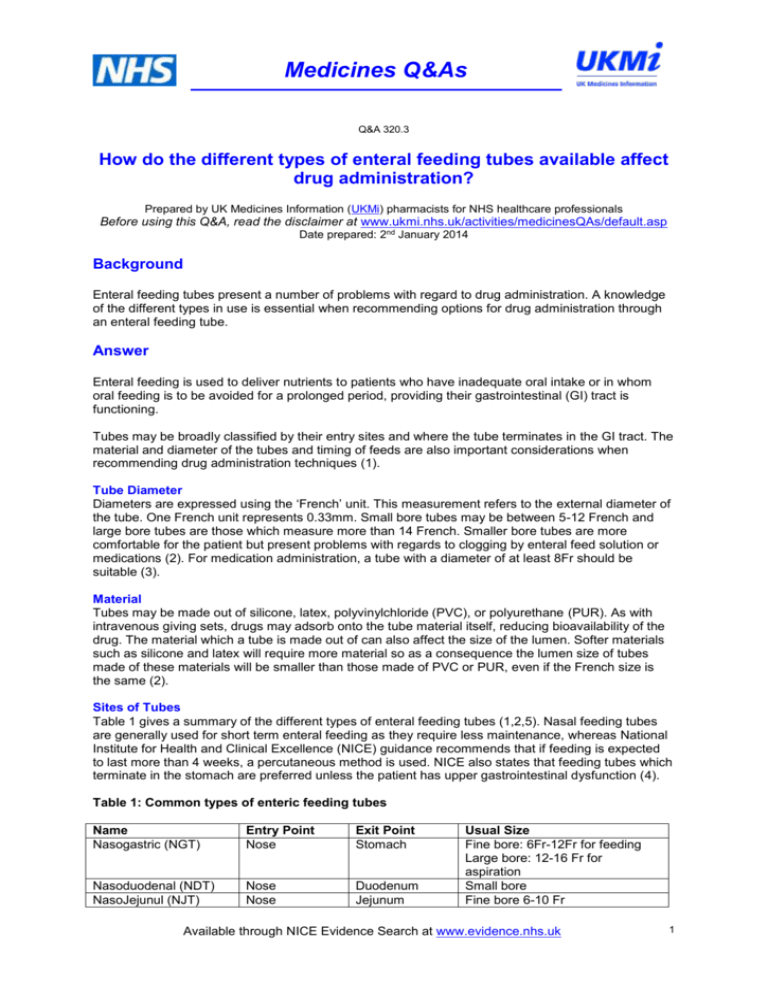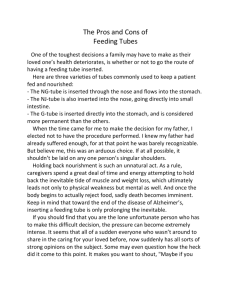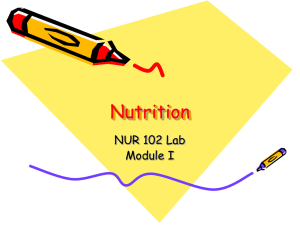UKMi Q&A xx - NHS Evidence Search
advertisement

Medicines Q&As Q&A 320.3 How do the different types of enteral feeding tubes available affect drug administration? Prepared by UK Medicines Information (UKMi) pharmacists for NHS healthcare professionals Before using this Q&A, read the disclaimer at www.ukmi.nhs.uk/activities/medicinesQAs/default.asp Date prepared: 2nd January 2014 Background Enteral feeding tubes present a number of problems with regard to drug administration. A knowledge of the different types in use is essential when recommending options for drug administration through an enteral feeding tube. Answer Enteral feeding is used to deliver nutrients to patients who have inadequate oral intake or in whom oral feeding is to be avoided for a prolonged period, providing their gastrointestinal (GI) tract is functioning. Tubes may be broadly classified by their entry sites and where the tube terminates in the GI tract. The material and diameter of the tubes and timing of feeds are also important considerations when recommending drug administration techniques (1). Tube Diameter Diameters are expressed using the ‘French’ unit. This measurement refers to the external diameter of the tube. One French unit represents 0.33mm. Small bore tubes may be between 5-12 French and large bore tubes are those which measure more than 14 French. Smaller bore tubes are more comfortable for the patient but present problems with regards to clogging by enteral feed solution or medications (2). For medication administration, a tube with a diameter of at least 8Fr should be suitable (3). Material Tubes may be made out of silicone, latex, polyvinylchloride (PVC), or polyurethane (PUR). As with intravenous giving sets, drugs may adsorb onto the tube material itself, reducing bioavailability of the drug. The material which a tube is made out of can also affect the size of the lumen. Softer materials such as silicone and latex will require more material so as a consequence the lumen size of tubes made of these materials will be smaller than those made of PVC or PUR, even if the French size is the same (2). Sites of Tubes Table 1 gives a summary of the different types of enteral feeding tubes (1,2,5). Nasal feeding tubes are generally used for short term enteral feeding as they require less maintenance, whereas National Institute for Health and Clinical Excellence (NICE) guidance recommends that if feeding is expected to last more than 4 weeks, a percutaneous method is used. NICE also states that feeding tubes which terminate in the stomach are preferred unless the patient has upper gastrointestinal dysfunction (4). Table 1: Common types of enteric feeding tubes Name Nasogastric (NGT) Entry Point Nose Exit Point Stomach Nasoduodenal (NDT) NasoJejunul (NJT) Nose Nose Duodenum Jejunum Usual Size Fine bore: 6Fr-12Fr for feeding Large bore: 12-16 Fr for aspiration Small bore Fine bore 6-10 Fr Available through NICE Evidence Search at www.evidence.nhs.uk 1 Medicines Q&As Percutaneous Gastrostomy (PEG) Percutaneous jejunostomy (PEJ) Percutaneous Gastrojejunostomy (PEGJ) Orogastric (OG) Abdomen Stomach Fine bore/ Large bore Abdomen Jejunum Small bore Abdominal wall Jejunum via the stomach Small bore Mouth Stomach Small/ Large bore Patients with severe gastro-intestinal reflux disease, pancreatitis or gastroparesis are more likely to have tubes which end in the small bowel (e.g. duodenum, jejunum or ileum) (1). Feeds Feeds may be administered continuously, intermittently, as a bolus, or in a cycle. Continual feeding will require interruptions for drug delivery but is the preferred method for jejunal tubes. Cyclic administration involves continuous feeding for a particular period. If administration is overnight, this may help to reduce the problems associated with drug-nutrient interactions. Bolus feedings, which most closely resemble normal feeding patterns, are used for gastric administration of feeds and can allow medication administration to be spaced between feedings. Intermittent feeding involves longer periods of drugs administration than bolus so medications can be carefully planned around feedings (1). Considerations for Medicines Administration via PEG tubes There are a number of factors to consider when administering medicines through an enteral feeding tube (1,2,3). These are set out in table 2. Table 2: Factors to consider when administering medicines through an enteral feeding tube Issue Size of tube Tube site Tube Function Feed timing Drug Administration Route Drug formulation Legal Implications Notes Narrow and long tubes are likely to become blocked by larger drug particles or viscous solutions (2). Tubes which terminate in the jejunum cause a particular concern for drug administration as the tube may bypass the site of drug absorption and the drug will be in the GI tract for a reduced amount of time. Drugs such as antacids, sucralfate, and bismuth are unlikely to work as they have a local effect in the stomach (1). Drugs such as ketoconazole, which require an acidic environment to be absorbed optimally, may have a reduced bioavailability (1). Conversely, increased bioavailability of some drugs such as opioid analgesics, beta-blockers, and tricyclic antidepressants, may occur due to reduced first-pass hepatic metabolism (1). Tubes which are being used for aspiration or drainage should not be used for drug administration purposes. This is particularly important for multilumen tubes as care must be taken to ensure drugs are administered into the correct lumen. Feeds may interact with drugs to reduce bioavailability. Can the drug be administered by a different route? E.g. intravenous, transdermal, buccal etc. Is the drug essential? For a list of injections which may be given orally, see Q&A number 175. Modified release formulations should not be given via a feeding tube. More viscous liquids e.g. syrups may clog tubes, as may larger drug particles. For most medications, administration through an enteral feeding tube is outside product licences. Available through NICE Evidence Search at www.evidence.nhs.uk 2 Medicines Q&As Summary Not all enteral feeding tubes are the same. Common types include nasogastric, nasojejunal, nasoduodenal, percutaneous gastrostomy, percutaneous jejunostomy and percutaneous gastrojejunostomy. Factors which may affect drug delivery include the size, placement, and function of the tube, as well as drug factors such as formulation and alternative administration routes. Limitations This Medicines Q&A is intended to be a quick reference summary to different types of enteral feeding tubes, in relation to medication issues. It does not detail individual drugs which may be administered via enteral feeding tubes. For information on administration of individual drugs via an enteral feeding tube, contact your local medicines information service, which you can find via the UKMi directory. Quality Assurance Prepared by Hayley Johnson, Regional Drug & Therapeutics Centre, Newcastle upon Tyne Date Prepared 2nd January 2014 Checked by Monica Mason, Regional Drug & Therapeutics Centre, Newcastle upon Tyne Date of check 2nd January 2014 Search strategy Embase: *PERCUTANEOUS ENDOSCOPIC GASTROSTOMY/ OR *TUBE FEEDING/ *OR ENTERIC FEEDING/ AND *DRUG ADMINISTRATION Medline: GASTROSTOMY/ OR ENTERAL NUTRITION/ AND drug administration.ti.ab (freetext search) In house resources NICE website References 1. Toedter Williams N. Medication administration through enteral feeding tubes. Am J Health Syst Pharm 2008; 65: 2347-2357. 2. White R and Bradnam V. Handbook of Drug Administration via Enteral Feeding Tubes. (online). London: Pharmaceutical Press; [Accessed via www.medicinescomplete.com on 02/01/2014] 4-8. 3. Mason P et al. Nutrition-Supporting Pharmacy Services. CPPE open learning programme. Outset Publishing: 2007, 80-85 4. National Institute for Health and Clinical Excellence. Clinical Guideline 32. Nutrition Support in Adults: oral nutrition support, enteral tube feeding and parenteral nutrition. 2006, page 30-31. Accessed via http://www.nice.org.uk/nicemedia/live/10978/29979/29979.pdf 5. Stroud M, Duncan H and Nightingale J. Guidelines for enteral feeding in adult hospital patients. Gut 2003; 52: vii1-vii12. Available through NICE Evidence Search at www.evidence.nhs.uk 3




